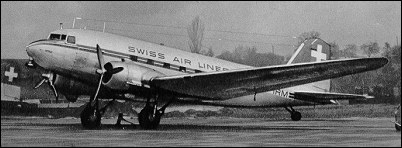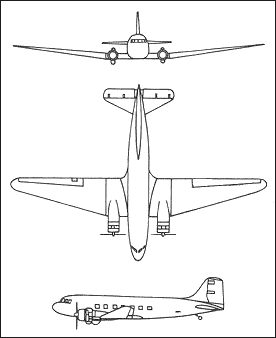|
| One of the world's truly outstanding aeroplanes, the DC-3 resulted from American Airlines' requirement for a sleeper aircraft for its US transcontinental route. The DC-2 fuselage was too small for this, so, reluctantly, in the autumn of 1934 Douglas agreed to build the DST (Douglas Sleeper Transport) as an enlarged DC-2, with lengthened fuselage, increased span and, most important, an increase of 66cm in fuselage width - allowing up to 28 seats or 14 sleeping berths.
The prototype DST, with 633.4-745kW Wright Cyclone SGR-1820 engines, made its first flight on 17 December 1935 (not inappropriately the 32nd anniversary of the first powered flight by the Wright Brothers). The type entered service with American Airlines on 25 June 1936 over the New York-Chicago route, with transcontinental sleeper services starting on 18 September. The DC-3/DST soon proved itself and orders grew rapidly, with KLM becoming the first operator outside the US. Including 40 DST, 430 DC-3 had been delivered when the USA entered the war - one flew more than 84,000 hours.
The aircraft had such enormous potential that it was ordered in very large numbers by the US armed forces and when production ceased in 1947 Douglas had built 10,654 examples of all civil and military variants; Nakajima and Showa in Japan had built 485 (L2D) and about 2,000 had been built in the USSR as PS-84, but later redesignated Lisunov Li-2 with 742kW Shvetsov engines.
The DC-3 was built in numerous versions and with a wide range of Wright Cyclone and Pratt & Whitney Twin Wasp engines ranging in power from 742 to 894kW. The aircraft were operated on wheels and skis - one even had floats (the XC-47G-DL) - and there was the XCG-17 experimental troop-carrying glider version. Original US military contracts covered 10,047 aircraft of which more than 9,500 were versions of the C-47 Skytrain with reinforced floor and double doors, and 380 G-53 Skytroopers. The US Navy ordered the DC-3 as the R4D. A wide range of military designations was given to civil aircraft impressed by the services before delivery including G-48, C-49, C-50, C-51, G-52, G-68 and C-84. Many military DC-3 were supplied to the US's allies and the 1,900 plus supplied to the RAF were given the name Dakota - a name which has been widely used in place of the correct DC-3 designation.
C-47 made such an important contribution to the US war effort that General Eisenhower considered them to be one of the four most significant weapons of World War II. In the China-Burma-India theatre they 'humped' supplies over the Himalayas from India to China and carried airborne troops on all major invasions. Post-war they contributed to the Berlin Airlift, carried supplies and troops into and wounded men out of Korea, and even fought as heavily armed gun-ships in Vietnam.
After World War II very large numbers of military DC-3 became surplus and were acquired by most of the world's airlines. In the early post-war years they formed the backbone of most airline fleets, initially with austere interiors but later brought up to much higher standards. Some were equipped to carry as many as 36 passengers but 21-28 was standard. Many others were used for cargo and mail.
External links

| MODEL | DC-3E |
| CREW | 2-3 |
| PASSENGERS | 21-28 |
| ENGINE | 2 x 1200hp Pratt Whitney R-1830-93 Twin Wasp |
| WEIGHTS |
| Take-off weight | 12700 kg | 27999 lb |
| Empty weight | 7697 kg | 16969 lb |
| DIMENSIONS |
| Wingspan | 28.96 m | 95 ft 0 in |
| Length | 19.57 m | 64 ft 2 in |
| Height | 5.16 m | 17 ft 11 in |
| Wing area | 91.69 m2 | 986.94 sq ft |
| PERFORMANCE |
| Max. speed | 369 km/h | 229 mph |
| Cruise speed | 293 km/h | 182 mph |
| Ceiling | 7071 m | 23200 ft |
| Range | 2414 km | 1500 miles |
| Albert Wilkat, e-mail, 04.01.2010 09:48 I am a WWII vet in the USAAC I got my pilot's wings in March, 1944 after flying the Cessna AT-17 as a cadet.I was sent to the China Burma India Theater in June and put in the right sedat of a C-47. Two weeks later, I flew as co-pilot on my first combat mission dropping supplies to our ground forces and over the Hump.In November, I checked out as first pilot. I was 23 years old. I ended up flying 191 missions, almost 800 hours in a C-47. I had my own plane named Abby's Cabby and it brought me home every time. I received three DFCs and four Air Medals. I still dream of how nice it was to grease one in at the short field we flew out of in Burma. I bet I could still do it. reply | | Jack Prebis, e-mail, 24.11.2009 01:44 I'm a photographer and want to fly around the world, roughly along the equator, on DC3s /C47s. I am thinking there are enough still certified (mostly as cargo planes) to do this. Probably should start by finding a registry of currently certified aircraft. Would appreciate any thoughts on the feasibility of such a trip. Thank you. reply | | Marsh Caldwell, e-mail, 15.10.2009 00:41 Does anyone out there have any "oficial" data that approves the installation of Pratt R1830-94 engines on DC3C aircraft? reply | | d.jay, 11.07.2009 00:30 Luis says its "My favourite transport aircraft of WWII" its mine of all time. reply | |
| | RAMÓN, e-mail, 04.06.2009 15:18 I'll allways remember this. A B-757 landed near a C-47 of Aeromarket in Mallorca airport, in which I was working, and the big plane pilot asked me permission to visit our small one. "This is the best all around the world", he said. reply | | Jim Arbuthnot, e-mail, 04.05.2009 22:05 I was a crew chief, flight mechanic on one of these in 1966. We flew out of Thailand and went all over the place. It was a good old plane with over 20,000 hrs. on it but it always go you to where you were going. reply | | Jock Williams Yogi 13, e-mail, 21.04.2009 15:24 The C47 was my first airplane ride when I was in grade 3 and a WW2 friend of my dads AC Ed Rheyno visited Kitchener.
Years later I would actually fly the C47 whenever I could scrounge the opportunity -I was a fighter pilot but appreciated classic airplanes and the "Racer" certainly fit that description.
There was quite a contrast between the "Dak" as the RCAF called her -and ANY fighter. Biggest of all was the huge bootfuls of rudder often required -particularly in crosswind takeoffs and landings!
Many say that the C47 was the aircraft that contributed most to our victory in WW2. I am proud to have flown the old girl under the tutelage of the inimitable Vern Schille. Those who know him will never forget him!
Jock Williams Yogi 13 reply | | Luis, e-mail, 06.09.2008 23:18 My favourite transport aircraft of WWII reply | | Grady Eaton, e-mail, 06.09.2008 14:39 Assigned to the Naval Attache' in Liberis in the 60's I flew as mechanic in one in West,North,and South Africa as well as Europe. Visited some airfields that were good. Some not quite so good. The old gooney took 'em all in stride. I was told by an old timer that while the Super DC-3 would get you 3 /4 of the way faster the DC-3 would get you all the way, just slower. He of course was refereing to the reliability of the P&W 1830's reply | | Bob Campbell, e-mail, 10.07.2008 08:38 My first airplane flight was on a C-47 from Lackland AFB in Texas to Keesler AFB in MS. I still remember it well, even tho I have since been on hundreds of commercial flights and flown almost 3 million miles. reply | | Roger Moore, e-mail, 20.06.2008 04:40 I flew the DC3 for Hawaiian Airlines in 1966. Once I learned how to get the Landing Gear up and down it was a delight to fly. Those of you who flew it know what I mean. reply | | AceAvakian, e-mail, 07.06.2008 03:27 ...with a little over 19,000 hours in the DC-3...there is no other airplane to equal it! When I dream aboutflying...I'm always flying a DC-3!! reply | | James Coffin, e-mail, 06.05.2008 02:49 I flew a USN C-47 in India 1964-1966. The Naval Attache office was acredited to Nepal also and we flew at least once monthly to Kathmandu from New Delhi. We covered all of India from Bombay to Calcutta and Bagdogra to Cochin. Also down into Ceylon. A reliable bird and if you could play soccer on a grass field, we could operate off of it. The Air Attache Convair had much greater speed but required 5-6,000' of concrete to operate. reply | | Tom Jones, e-mail, 03.04.2008 05:29 I note that you have not included the Super DC3 or Navy
C117. Can you add this to your collection? reply | |
| | Tolik, e-mail, 05.08.2007 21:28 Я поражен такой без отказной техникой котороя работает со времен ВТОРОЙ МИРОВОЙ reply |
|
Do you have any comments?
|
| 
COMPANY
PROFILE
All the World's Rotorcraft
|








